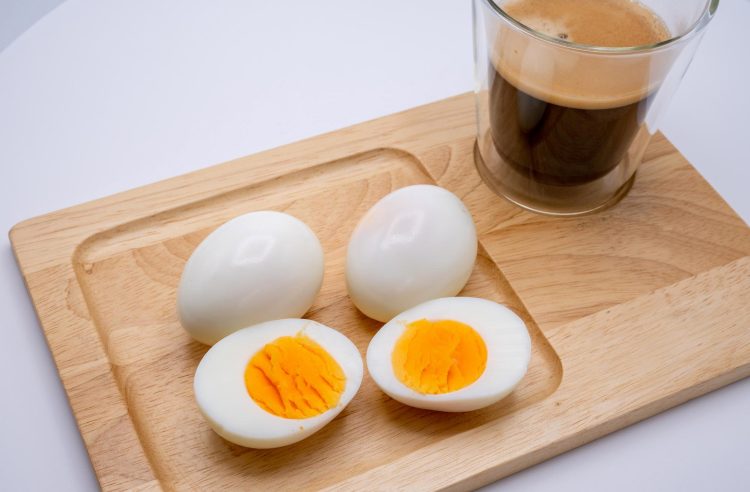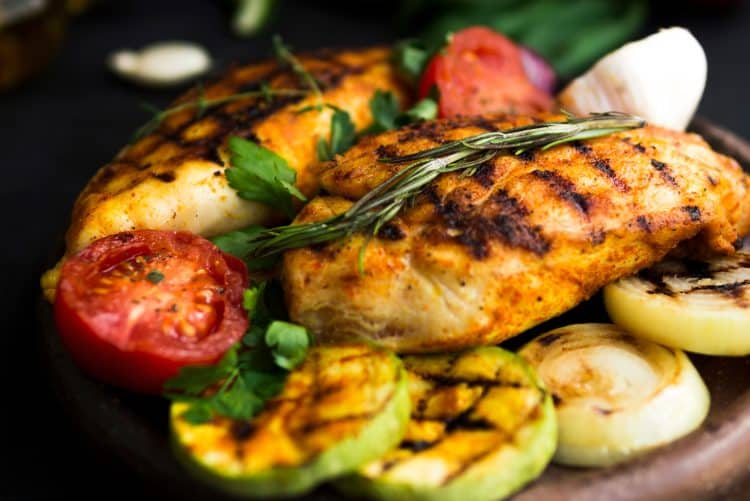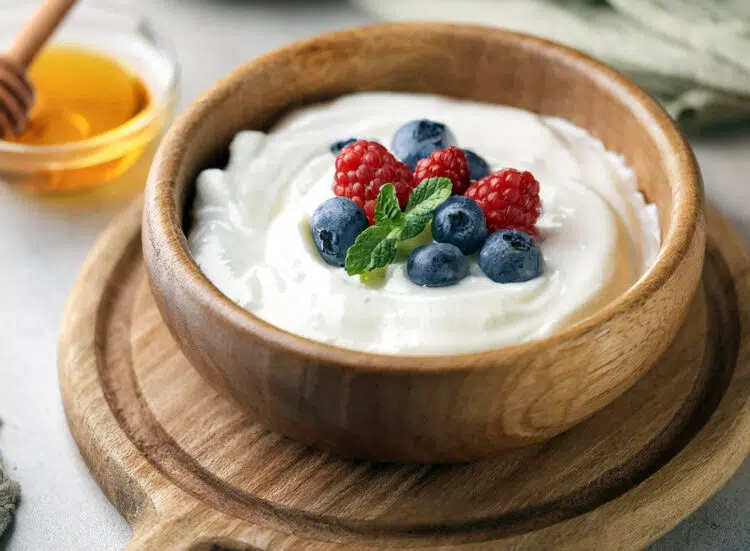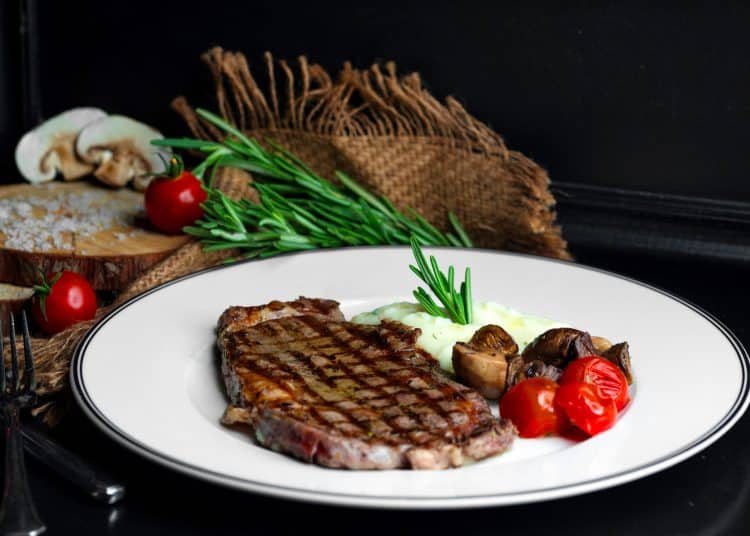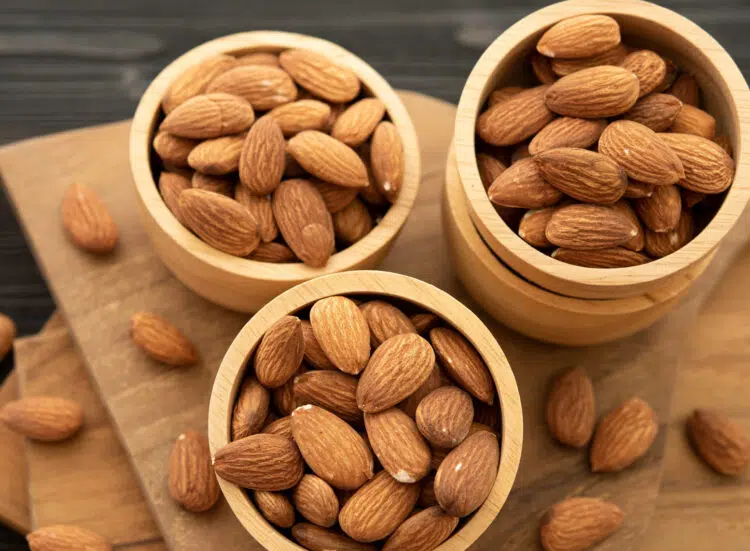Building muscle and strength requires a holistic training, recovery, and diet approach. Lifting weights develops microtears in the muscle fibers. No matter how hard you train in the gym, your muscles won’t grow bigger and stronger without adequate nutrition for optimal recovery.
While a high-protein diet can promote muscle protein synthesis and hypertrophy, a balanced diet is just as important for strength gains. You need an ample nutrient supply, especially glycogen from carbs, to fuel your workouts effectively.
As a personal trainer with over 17 years in the trenches, I’ve seen firsthand the impact a structured diet can have on your results.
Remember, no two foods are created equal. Building muscle usually involves a calorie surplus, meaning you must consume more calories in a day than you expend. However, you must prioritize nutrient-dense, whole foods instead of greasy, high-fat foods to maintain an aesthetically appealing body composition.
In this article, I will unveil the eight foods that should be a staple in your fitness diet, along with their science-backed benefits and tips on how to incorporate them into your routine.
8 Muscle-Building and Strength-Boosting Foods

Before we dive into the nitty-gritty of the eight foods that should be a part of your diet plan, here’s a little brush-up on the three macronutrients and why each of them deserves a place in your diet:
Level Up Your Fitness: Join our 💪 strong community in Fitness Volt Newsletter. Get daily inspiration, expert-backed workouts, nutrition tips, the latest in strength sports, and the support you need to reach your goals. Subscribe for free!
Protein is the building block of muscle. Nutrition scientist Dr. Layne Norton recommends eating at least one gram of protein per pound of body weight to maximize hypertrophy. Carbohydrates are the body’s primary energy source, whereas dietary fats support various bodily functions, including hormone production.
Use this total daily energy expenditure (TDEE) calculator to determine your ideal daily macro goals.
1. Eggs
Eggs are one of my favorite food sources. They are packed with protein, are quickly absorbed by the muscles, and are incredibly easy to cook. Eggs are a complete protein source, meaning they have all the nine essential amino acids, which the body can’t produce on its own but needs to maximize muscle and strength gains.
Hard-boiled eggs are my go-to snack whenever I am starving and don’t have access or time to cook healthy meals.
Besides its high-protein content, eggs also deliver a decent punch of vitamin D, B12, and choline. Eating eggs right after a training session can be an excellent option as your muscles soak up nutrients like a sponge during that time.
Research suggests that the recommended amount of leucine to maximize muscle protein synthesis lies between 700 and 3000 mg. One egg contains around 500 mg of leucine, making it a muscle-building superfood. (1)
This versatile food source can be added to a variety of recipes and is incredibly affordable. You could eat scrambled, fried, poached, or hard-boiled eggs or add them to salads, sandwiches, or wraps.
One large egg delivers around six grams of protein and five grams of healthy fats — mostly from the yolk.
2. Chicken Breast
Chicken breast is a staple in most bodybuilders’ diets. It is a lean protein source that is low in fat and calories, which can help muscle growth and recovery after workouts.
Chicken breast is also an excellent food for boosting your metabolism as it contains niacin, which supports energy metabolism, and vitamin B6, which helps with protein metabolism.
Cook chicken breast the way you like it the most. Grill, bake, or sauté; there are no wrong answers here. You could also add it to salads, wraps, or stir-fries. I have recently developed a liking for shredding it and adding it to sandwiches or tacos.
If you’re not a fan of the good old chicken breast with rice, you can add it to a variety of dishes depending on your preferences.
A three-ounce serving of cooked chicken breast contains around 26 grams of protein. It also contains just three grams of fat per serving.
3. Salmon
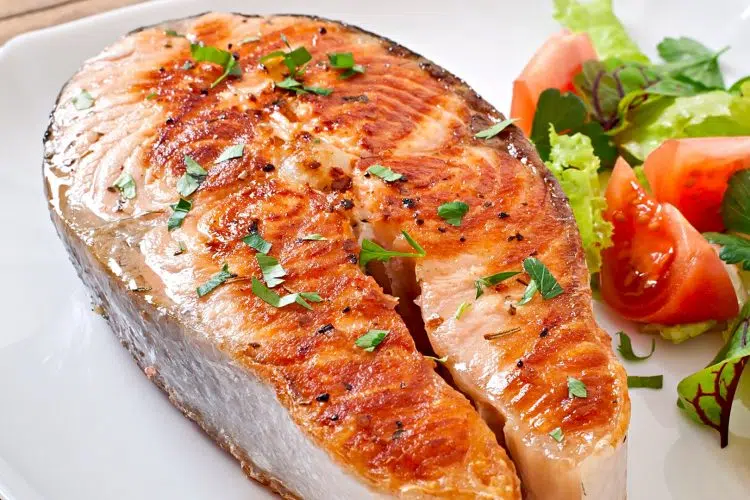
Most fish are highly bioavailable, meaning your body absorbs the nutrients quickly (2). Although you can have fish at any point during the day, I usually save it for my post-workout meals, as it is easily digested and kickstarts the recovery process.
Besides its high protein content, salmon is one of the best omega-3 fatty acid sources, which plays a vital role in several body functions, including boosting heart health and immunity, brain development, and lowering inflammation.
Salmon is packed with vitamin D, which is essential for muscle function, and vitamin B12, crucial for energy metabolism.
One of the best things about salmon is that it is incredibly easy to cook. You could grill, bake, or pan-sear salmon and eat it with a side of veggies and brown rice. Just thinking about this meal makes me hungry. You now know what I’m having for dinner.
A three-ounce serving of cooked salmon contains 22 grams of protein and 13 grams of high-quality fat.
4. Greek Yogurt
Greek yogurt is my side of choice, and I have at least one serving of low-fat yogurt daily. I like to think of Greek yogurt as my cheat meal and add a generous amount of nuts, seeds, and granola to it for a satisfying crunch. Plus, I top it off with a spoonful of honey to make it taste like a dessert.
Greek yogurt delivers a good dose of calcium and Vitamin B12, which helps avoid micronutrient deficiencies. It is also incredibly effective for boosting your gut microbiome and promoting nutrient absorption.
Level Up Your Fitness: Join our 💪 strong community in Fitness Volt Newsletter. Get daily inspiration, expert-backed workouts, nutrition tips, the latest in strength sports, and the support you need to reach your goals. Subscribe for free!
If you’re not a fan of the standard Greek yogurts, you can use it as a base for dips or sauce. Some of my clients use it as a substitute for sour cream.
You must avoid the temptation to buy flavored Greek yogurt as they are laden with added sugars. You could also opt for lactose-free or dairy-free alternatives, depending on your preferences.
A six-ounce serving of plain Greek yogurt provides around 17 grams of protein and only six grams of carbs.
5. Lean Beef
Beef is a high-quality protein source and also contains essential nutrients like iron (which helps with oxygen transport in the blood) and zinc (which supports immune function and protein synthesis).
Whenever you are shopping for beef, make sure you always get the lean version (nothing below the 70/30 mark). This is even more important when you are trying to get rid of excess body fat.
You could grill, broil, or pan-sear lean beef and enjoy it with a side of veggies or sweet potatoes.
However, most nutrition experts don’t recommend eating beef more than once daily as it can increase the risk of colorectal cancer. (3)
A three-ounce serving of cooked lean beef provides 25 grams of protein and five grams of fat.
6. Quinoa
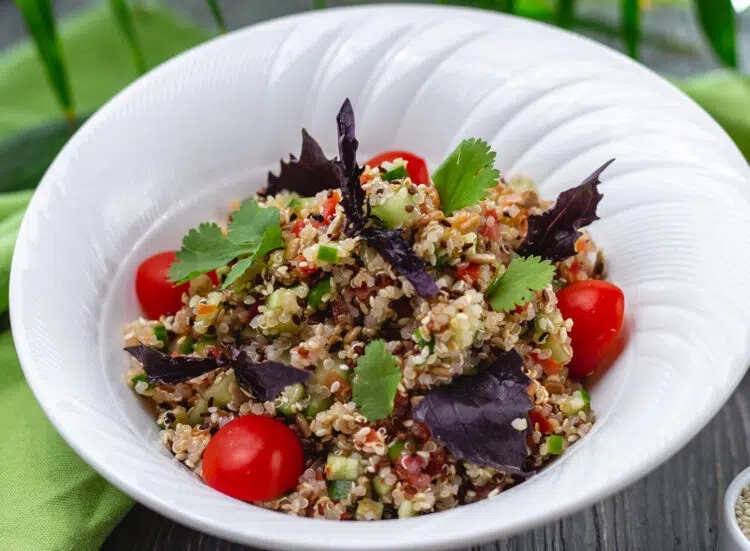
Quinoa is one of the most unassuming food sources but has been a staple in my breakfast menu for several years due to its several benefits.
It is a complex carbohydrate that ensures a consistent energy supply throughout the day. Quinoa is a complete protein source and can help promote recovery for optimal muscle and strength gains.
It is also an excellent source of fiber, which helps improve your gut health and keeps you feeling full for an extended period. Besides this, quinoa is a good source of magnesium and iron, helping you hit your RDA goals.
I suggest cooking quinoa and using it as a base for salads. Alternatively, you can add it to soups, stews, or stir-fries.
A cooked cup of quinoa comprises eight grams of protein, five grams of fiber, and 39 grams of carbs.
7. Lentils
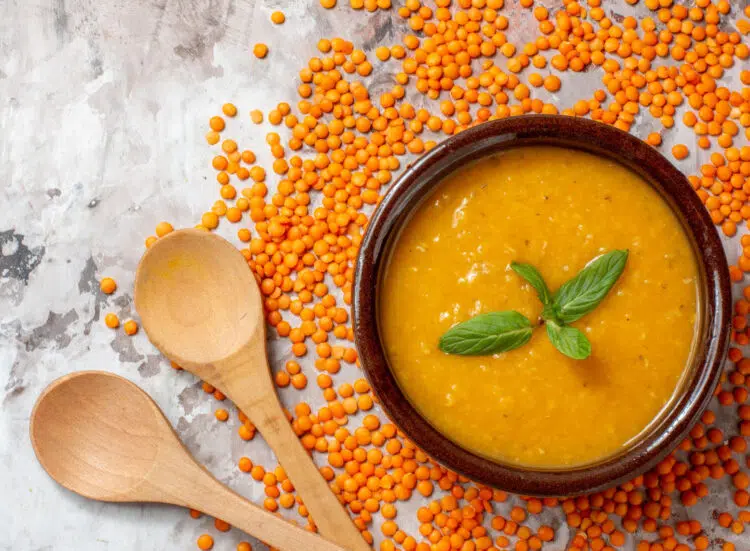
Lentils are one of the best muscle and strength-building food sources for vegetarians and vegans. This versatile food source can be cooked in several ways — add it to soups, stews, salads, or wraps. I sometimes use them to make veggie burgers or lentil loaf.
Besides iron, lentils are a rich source of folate, which can boost cell growth and development. This is exactly what we want when trying to maximize muscle and strength gains.
Some people might experience gas or bloating after eating lentils. In this case, you could start with small portions and monitor how your body responds to them.
Plus, there are four main categories of lentils (brown, green, red/yellow, and specialty). Try different types of lentils to determine which works best for you.
A cooked cup of lentils delivers around 18 grams of protein, 40 grams of carbs, and 15 grams of fiber.
8. Almonds
If you are looking for a healthy snacking option, your search ends here. Almonds are tree nuts that are packed with healthy fats, protein, fiber, vitamin E (a potent antioxidant), and magnesium (which supports muscle function and energy metabolism).
Research suggests that regular almond intake can alleviate perceived muscle soreness and potentially enhance muscle functional capacity during recovery from strenuous exercise. (4)
Although I usually eat almonds as a snack between meals to avoid cravings, I sometimes also add them to yogurt and oatmeal to spike their fat content and get that satisfying crunch.
A one-ounce serving of almonds delivers around six grams of protein, 3.5 grams of fiber, and 14 grams of fat.
Conclusion
I like to think of my body as a high-performance machine, and I feed it only the most premium fuel to ensure it is always operating at its peak. Prioritize nutrient-dense, whole foods and a balanced macronutrient split to maximize hypertrophy and strength gains and achieve your fitness goals.
Remember, you don’t have to add all these foods to your diet at once. Start small and see how your body reacts to these new additions. Make necessary adjustments and constantly switch the foods in your diet to keep things interesting and avoid nutrient deficiencies.
Patience, consistency, and discipline are your best friends when it comes to building a chiseled physique. Stick to a personalized routine for the long term, and the results will follow. Best of luck!
If you have any questions about the eight foods listed in this article, drop them in the comments below, and I’ll be happy to help!
References:
- Puglisi MJ, Fernandez ML. The Health Benefits of Egg Protein. Nutrients. 2022;14(14):2904. Published 2022 Jul 15. doi:10.3390/nu14142904
- Fox, T. E., Van den Heuvel, E. G., Atherton, C. A., Dainty, J. R., Lewis, D. J., Langford, N. J., Crews, H. M., Luten, J. B., Lorentzen, M., Sieling, F. W., van Aken-Schneyder, P., Hoek, M., Kotterman, M. J., van Dael, P., & Fairweather-Tait, S. J. (2004). Bioavailability of selenium from fish, yeast, and selenate: a comparative study in humans using stable isotopes. European journal of clinical nutrition, 58(2), 343–349. https://doi.org/10.1038/sj.ejcn.1601787
- Farvid, M. S., Sidahmed, E., Spence, N. D., Mante Angua, K., Rosner, B. A., & Barnett, J. B. (2021). Consumption of red meat and processed meat and cancer incidence: a systematic review and meta-analysis of prospective studies. European journal of epidemiology, 36(9), 937–951. https://doi.org/10.1007/s10654-021-00741-9
- Siegel L, Rooney J, Marjoram L, et al. Chronic almond nut snacking alleviates perceived muscle soreness following downhill running but does not improve indices of cardiometabolic health in mildly overweight middle-aged adults. Front Nutr. 2024;10:1298868. Published 2024 Jan 8. doi:10.3389/fnut.2023.1298868

